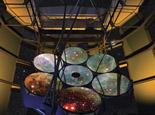
The Smithsonian is delighted to be included in this year's Aspen Ideas Festival (June 26 – July 2 in Aspen, Colo.) which will gather some of the most interesting thinkers and leaders from around the United States and abroad to discuss their work, the issues that inspire them, and their ideas. This year Charles Alcock, director of the Harvard-Smithsonian Center for Astrophysics; Justin Kasper, astrophysicist at the Harvard-Smithsonian Center for Astrophysics; and Maria Banks, a geologist at the National Air and Space Museum's Center for Earth and Planetary Studies are among the participants of the Aspen Ideas Festival. The questions and answers below are designed to give readers a better understanding of the remarkable work that these three scientists do with links to a number of relevant Smithsonian Web sites.
Q: Are we alone in the universe?
A: The jury is still out. However, Dr. Charles Alcock and a core group of international partners are seeking to answer this question. Alcock is leading the Harvard-Smithsonian Center for Astrophysics' work as one of the founding partners of the Giant Magellan Telescope, which will image the universe with ten times the sharpness of the Hubble Space Telescope and see farther back in time than ever before possible. Stay tuned for first light in 2020. For more information on the Giant Magellan Telescope click here.
Q: How do you touch a star?
A: Very carefully. Astrophysicists like Dr. Justin Kasper, the youngest lead on any NASA mission, are busy testing materials like synthetic sapphire and building one of the first instruments that will literally "touch" the sun. The Solar Wind Electrons Alphas and Protons (SWEAP) investigation will be launched on NASA's Solar Probe Plus in 2018. For more information on SWEAP and Dr. Justin Kasper's work, please click here.